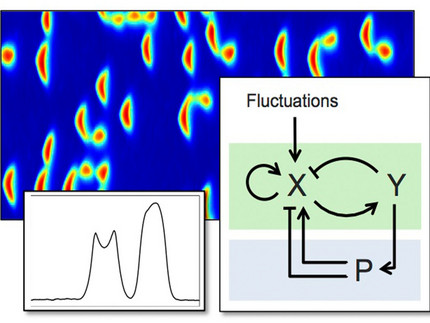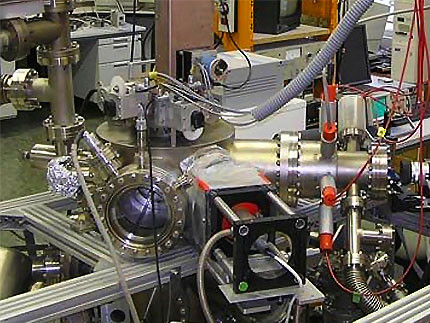Pattern formation and modeling
Intracellular dynamics
We rationalize the results of our experimental work based on conceptual toy models that are designed to capture the main dynamical features of the biological processes we study. These include mechanisms of directional sensing and polarity formation but also generic models of cytoskeletal dynamics. They are typically inspired by concepts of nonlinear dynamics and include basic analytical approaches as well as numerical simulations.
- O. Nagel, C. Guven, M. Theves, M. Driscoll, W. Losert and C. Beta, PLoS ONE, 9 (12), e113382 (2014).
- C. Westendorf, J. Negrete Jr., A.J. Bae, R. Sandmann, E. Bodenschatz, and C. Beta, PNAS 110, 3853-3858 (2013).
- C. Beta, G. Amselem, and E. Bodenschatz, New J. Phys. 10, 083015 (2008).
Reaction-diffusion systems
Our group has a long-standing interest in pattern formation with a focus on reaction-diffusion systems. We have analyzed the statistical properties of topological defects to characterize spatiotemporally chaotic dynamics (defect-mediated turbulence). Time-delayed feedback schemes to control chaotic states and to induce desired spatiotemporal patters is a second focus of our work. Further present and past research topics include the effects of cross-diffusion and advection and the application of wavelet filters to turbulent reactive flows. We have worked on generic models like the complex Ginzburg-Landau equation but also on specific systems like the Oregonator, the Gray-Scott model, or the Krischer-Eiswirth-Ertl model of catalytic CO oxidation.
- M. Stich, A. Casal, and C. Beta. Phys. Rev. E 88, 042910 (2013).
- I. Berenstein and C. Beta, J. Chem. Phys. 135, 164901 (2011).
- D. Krefting and C. Beta, Phys. Rev. E 81, 036209 (2010).
- C. Beta and A.S. Mikhailov, Physica D 199, 173-184 (2004).
- C. Beta, K. Schneider, M. Farge, and H. Bockhorn, Chem. Engin. Sci. 58, 1463-1477 (2003).
Nonlinear surface reactions
Our research in the past was focused on nonlinear surface chemical reaction. Here, we performed experimental work on the space-time dynamics of adsorbate patterns during catalytic CO oxidation on platinum surfaces with a particular focus on controlling such patterns with the help of delayed feedback schemes. The experimental studies were carried out in a UHV chamber using photoemission electron microscopy (PEEM) to obtain spatially resolved real time images of the concentration patterns on the catalyst surface. Both uniform and non-uniform coupling schemes were explored to control pattern formation in the experiment. Mathematical modeling closely complemented our experimental work and involved detailed kinetic models as well as amplitude equations and phase field descriptions.
- C. Beta, A.S. Mikhailov, H.H. Rotermund, and G. Ertl, Europhys. Lett. 75, 868-874 (2006).
- H. Varela, C. Beta, A. Bonnefont, and K. Krischer, Phys. Rev. Lett. 94, 174104 (2005).
- C. Beta, M.G. Moula, A.S. Mikhailov, H.H. Rotermund, and G. Ertl, Phys. Rev. Lett. 93, 188302 (2004).
- C. Beta, M. Bertram, A.S. Mikhailov, H.H. Rotermund, and G. Ertl, Phys. Rev. E, 67, 046224 (2003).



